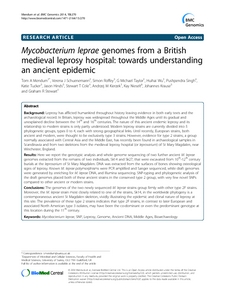Mendum, TA;
Schuenemann, VJ;
Roffey, S;
Taylor, GM;
Wu, H;
Singh, P;
Tucker, K;
Hinds, J;
Cole, ST;
Kierzek, AM;
et al.
Mendum, TA; Schuenemann, VJ; Roffey, S; Taylor, GM; Wu, H; Singh, P; Tucker, K; Hinds, J; Cole, ST; Kierzek, AM; Nieselt, K; Krause, J; Stewart, GR
(2014)
Mycobacterium leprae genomes from a British medieval leprosy hospital: towards understanding an ancient epidemic.
BMC Genomics, 15 (270).
ISSN 1471-2164
https://doi.org/10.1186/1471-2164-15-270
SGUL Authors: Hinds, Jason
![[img]](https://openaccess.sgul.ac.uk/107232/1.hassmallThumbnailVersion/Mycobacterium_leprae_genomes.pdf)  Preview |
|
["document_typename_application/pdf; charset=binary" not defined]
Published Version
Download (711kB)
| Preview
|
Abstract
BACKGROUND: Leprosy has afflicted humankind throughout history leaving evidence in both early texts and the archaeological record. In Britain, leprosy was widespread throughout the Middle Ages until its gradual and unexplained decline between the 14th and 16th centuries. The nature of this ancient endemic leprosy and its relationship to modern strains is only partly understood. Modern leprosy strains are currently divided into 5 phylogenetic groups, types 0 to 4, each with strong geographical links. Until recently, European strains, both ancient and modern, were thought to be exclusively type 3 strains. However, evidence for type 2 strains, a group normally associated with Central Asia and the Middle East, has recently been found in archaeological samples in Scandinavia and from two skeletons from the medieval leprosy hospital (or leprosarium) of St Mary Magdalen, near Winchester, England.
RESULTS: Here we report the genotypic analysis and whole genome sequencing of two further ancient M. leprae genomes extracted from the remains of two individuals, Sk14 and Sk27, that were excavated from 10th-12th century burials at the leprosarium of St Mary Magdalen. DNA was extracted from the surfaces of bones showing osteological signs of leprosy. Known M. leprae polymorphisms were PCR amplified and Sanger sequenced, while draft genomes were generated by enriching for M. leprae DNA, and Illumina sequencing. SNP-typing and phylogenetic analysis of the draft genomes placed both of these ancient strains in the conserved type 2 group, with very few novel SNPs compared to other ancient or modern strains.
CONCLUSIONS: The genomes of the two newly sequenced M. leprae strains group firmly with other type 2F strains. Moreover, the M. leprae strain most closely related to one of the strains, Sk14, in the worldwide phylogeny is a contemporaneous ancient St Magdalen skeleton, vividly illustrating the epidemic and clonal nature of leprosy at this site. The prevalence of these type 2 strains indicates that type 2F strains, in contrast to later European and associated North American type 3 isolates, may have been the co-dominant or even the predominant genotype at this location during the 11th century.
| Item Type: |
Article
|
| Additional Information: |
© 2014 Mendum et al.; licensee BioMed Central Ltd. This is an Open Access article distributed under the terms of the Creative Commons Attribution License (http://creativecommons.org/licenses/by/2.0), which permits unrestricted use, distribution, and reproduction in any medium, provided the original work is properly credited. The Creative Commons Public Domain Dedication waiver (http://creativecommons.org/publicdomain/zero/1.0/) applies to the data made available in this article, unless otherwise stated. |
| Keywords: |
Archaeology, Bone and Bones, Epidemics, Evolution, Molecular, Genome, Bacterial, Genotype, Great Britain, History, 15th Century, History, 16th Century, History, Medieval, Humans, Leprosy, Mycobacterium leprae, Osteology, Phylogeny, Polymorphism, Single Nucleotide, Sequence Analysis, DNA, Skeleton, Genome, SNP, Ancient DNA, Middle Ages, Bioarchaeology, Science & Technology, Life Sciences & Biomedicine, Biotechnology & Applied Microbiology, Genetics & Heredity, BIOTECHNOLOGY & APPLIED MICROBIOLOGY, GENETICS & HEREDITY, Bioarchaeology, LEPROMATOUS LEPROSY, TUBERCULOSIS, ANTIQUITY, ENGLAND, DNA, INDIA, Bioinformatics, 06 Biological Sciences, 11 Medical And Health Sciences, 08 Information And Computing Sciences |
| SGUL Research Institute / Research Centre: |
Academic Structure > Infection and Immunity Research Institute (INII) |
| Journal or Publication Title: |
BMC Genomics |
| ISSN: |
1471-2164 |
| Language: |
eng |
| Dates: |
| Date | Event |
|---|
| 8 April 2014 | Published |
|
| PubMed ID: |
24708363 |
| Web of Science ID: |
WOS:000334958700001 |
 |
Go to PubMed abstract |
| URI: |
https://openaccess.sgul.ac.uk/id/eprint/107232 |
| Publisher's version: |
https://doi.org/10.1186/1471-2164-15-270 |
Statistics
Item downloaded times since 11 Dec 2014.
Actions (login required)
 |
Edit Item |



